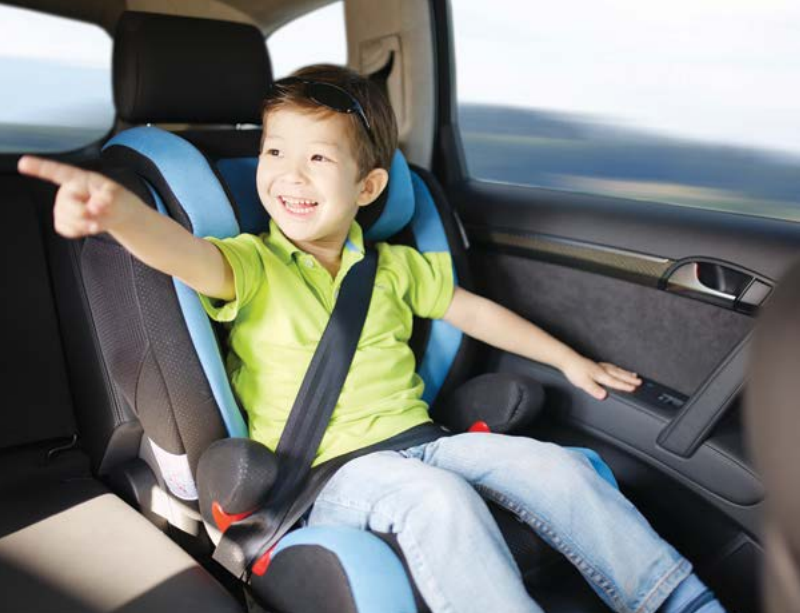As a parent, you want to do everything in your power to keep your kids as safe as possible. But when it comes to car-seat safety, it’s often easier said than done.
Not only do the laws change when new information about best practices becomes available, sometimes we assume that the legal requirements (see resources below) are enough, when, in truth, the laws don’t necessarily reflect the safest standards recommended by various child-focused organizations such as the American Academy of Pediatrics.
Car crashes are the No. 1 killer of children age 4 and older and a leading cause of death for younger kids, too, according to the AAP, so becoming educated about current laws and best practices is one of the most important things you can do.
Infants and Toddlers
Let’s start with the every-day stuff: With infants and toddlers, make sure the car-seat straps are tight enough and properly positioned.
This means that the chest clip should be at armpit level, straps shouldn’t be twisted and you shouldn’t be able to easily fit your fingers between the strap and your baby.
The middle of the backseat is the safest spot in the car, offering your child 43 percent more protection than a side seat in the back, so whenever possible, use this option. When you have more than one child riding in your car, the smallest child should be placed in the middle seat position.
Rear-facing encouraged longer
Finally, and perhaps most controversial, is which way to face your child’s seat after he or she turns 1 (and weighs 20 pounds): The AAP now recommends that all children younger than 2 remain in a rear-facing seat or as long as possible.
Furthermore, if your child is under the manufacturer’s weight limit for their convertible car seat — and the car seat is at least 1 inch taller than the top of their head — they’re safer in the rear-facing position even after age 2, according to the APP.
To some parents, those recommendations may seem strange. Putting growing children age 1 or older in a rear-facing seat often requires them to sit with their feet or legs crossed and pressed against the back seat, especially if they have longer legs. It looks cramped, if not unsafe, for their legs.
Many parents — and organizations such as the online passenger safety resource, CPSafety.com — adamantly agree with APP recommendation.
CPSafety’s web site argues that no leg, hip or other injuries have been reported due to a child being in a collision in a rear-facing seat. There are, however, many reported cases of head and neck injuries among forward-facing children.
CPSafety, which also factors in recommendations from Safe Kids Worldwide and the National Highway Traffic Safety Administration, argues that legs and hips, even if they are injured, can be fixed and rarely cause fatal complications.
Spinal cord damage that can be caused when a young child is in an accident in a front-facing seat, is different, the organization contends.
Other parents worry that if they’re hit from behind in a car crash, their child could be safer in a front-facing seat because of the direction of the impact. But fatal rear-impact accidents are surprisingly rare when compared with frontal and side impacts, according to CPSafety.
Heather Darby, an occupant protection coordinator for Minnesota’s Office of Traffic Safety, said children are five times safer when placed in rear-facing car seats.
“Rear-facing, their whole body is absorbing the force of that crash, not their neck and spine,” Darby said. “Their bodies aren’t developed enough to be forward-facing.”
Watch seat weight limits
Paying attention to weight limits is extremely important for all car seats, too, Darby said. Using a seat beyond its weight limits can be dangerous.
“That would be just as wrong as turning them around too soon,” Darby said. “They’re (car seats) crash tested at specific weights and heights.”
Weight limits are usually printed on the side of every car seat, so you don’t have to read the manual or remove the seat to find them.
“If the label is missing,” Darby said, “you should not use the seat.”
Before the APP made its rear-facing recommendation a few years ago, car seats weren’t as easy to rear face for very long because their weight limits topped out at about 30 pounds, Darby said.
Recently, however, manufacturers have responded with rear-facing seat weights that go up to 35 or 40 pounds to make it easier.
Preschoolers
One of the No. 1 car-safety mistakes parents make with older toddlers and preschoolers is moving them out of a regular car seat and into a booster too soon.
Children should remain in a regular child car seat until they’re at least 4 years old and weigh between 40 and 60 pounds.
Check the height and weight limits on your child’s car seat, and don’t transition them into a booster until they’ve reached those manufacturer’s limits.
Choose a booster seat that comes with a 5-point restraint and converts into a seat that can used with a seatbelt; and be sure to check the weight limits in relation to your child.
The safest boosters allow for the use of the five-point restraint to higher weights, such as 70 pounds, and can be used with a seatbelt for kids weighing 100 or more pounds.
Another issue that parents with children in this age range must address immediately and consistently is the propensity of kids to become escape artists. Before the car starts moving, let your children know they have to stay buckled, and that, if they don’t, the car stops moving.
Be consistent about pulling over and turning off the engine when your child unbuckles.
For most toddlers and preschoolers, the game grows tedious quickly.
Older Children
Older children should remain in a booster until they’re at least 8 years old and have reached 4 feet, 9 inches tall.
A child isn’t big enough to be out of a booster until the seatbelt fits properly, which means the lap belt rests across the thighs, not the stomach, and the chest belt lies on the chest without crossing the neck.
Darby said it’s counter-intuitive for some parents to delay forward-facing seats, boosters and even regular car-seat riding.
“We’re always kind of looking for that next milestone. When it comes to car seats, you want to do the opposite,” said Darby, adding that her 7-year-old daughter is still in a booster seat.
While there’s no law in Minnesota about keeping a child in the backseat once they’ve moved out of a booster, the backseat remains the safest place for all children until they’re 13 years old because airbags can be deadly in crashes with younger children.
RESOURCES
Minnesota laws
• Infants (weighing less than 20 pounds and younger than age 1) must be in a rear-facing safety seat.
• All children younger than 8 years old must ride in a federally approved car seat or booster seat, unless the child is 4 feet, 9 inches or taller.
• Safety seats must be installed and used according to the manufacturer’s instructions.
Get checked!
In Minnesota, three out of four car seats are installed incorrectly — a sobering statistic when you consider that an improperly installed car seat can be as dangerous as none at all. However, there are free car-seat safety stations throughout the state, where trained individuals can check your car seat installation and make the necessary changes. To set up an appointment, go to tinyurl.com/mncarseatchecks. Learn more — and order free dinosaur booster seat stickers — at dps.mn.gov/divisions/ots.
Can kids wear coats?
Many car-seat manufacturers and other organizations now recommend that younger children not wear coats, especially bulky winter ones, when riding in car seats. Why? Bulky fabric can make it impossible to adequately tighten the straps, which can lead to the child slipping right out of the restraints during a forceful collision. To see if your child’s coat is too bulky, you can try a simple pinch-test measurement: Learn more at tinyurl.com/carseatcoattest.
Keeping warm in Minnesota is always tricky, of course, so some kids might have to cover up with blankets. If you have an infant, you can buy specially designed car-seat covers to keep them warm.
How do I recycle an old car seat?
There are drop-off sites for car-seat recycling in Chaska, Coon Rapids, Hutchinson, and Watertown. See tinyurl.com/carseatrecycle.
Mani Canaday is a freelance writer and a regular contributor to Minnesota Parent.























